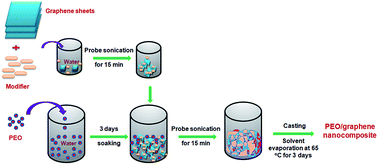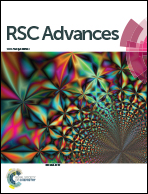Novel green method of preparation of a poly (ethylene oxide)/graphene nanocomposite using organic salt assisted dispersion
Abstract
Nanocomposites of poly (ethylene oxide) (PEO) and graphene were made in aqueous solution using an organic salt containing a carboxylate ion and a carboxylic acid group. The cation corresponding to the carboxylate ion interacts with the π electron clouds of graphene through cation–π interaction and promotes the exfoliation of graphene sheets. The carboxylic acid group of the modifier forms H-bonds with the PEO and thereby improves interfacial adhesion. The effect of the number of carbon atoms present in the modifier on its dispersing ability was investigated. It was observed that there exists an optimum number of carbon atoms present in the modifier with respect to the level of dispersion of graphene in the related nanocomposites as examined by scanning electron microscopy (SEM) and transmission electron microscopy (TEM). The mechanical properties of the nanocomposites having various concentrations of graphene were evaluated and compared with the theoretical values using the Halpin–Tsai model. The crystallization behavior of the PEO upon incorporation of modified graphene was studied by temperature modulated differential scanning colorimetry (MDSC) and discussed as well. The dispersion process used here is green as it does not require any toxic solvent or hazardous material for modification of graphene.


 Please wait while we load your content...
Please wait while we load your content...